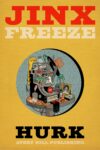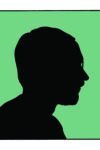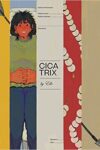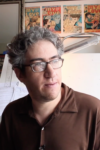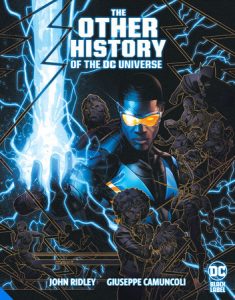
[DC Comics; 2021]
While DC comics predated Marvel by decades, it always seems to come at its heels. As far back as the 1990s, sales of DC came in far behind Marvel (yet still above Dark Horse or then-newbies like Image). The conventional logic is that Marvel has the more sophisticated, sci-fi storytelling and a more coherent shared world, and DC’s heroes are too old, two few, and too godlike. When DC does its best it plays to those strengths, like it did in the 1990s with the Vertigo imprint, that took its own canon into a hyperreal space of adult themes, postmodern storytelling sensibilities, creating a radical shift in what superhero and genre storytelling could be. It paved the way for the genre books of Image and other lines today, as well as adult-oriented mainstream comics, meaning readers no longer had to turn to the literary likes of Fantagraphics if they wanted serious comic storytelling. It was action, adventure, and grand narratives for adults, and DC banked its image on that slight bit of maturity.
DC has always kept an adult imprint, and more recently it has tried to reign it back into the DC universe with DC Black. Vertigo had gone the way of “creator owned” books in the 2000s, which means that trademark characters were left out of “mature readers” series in favor of new stories introduced just by the writers and artists themselves. The problem was that Image, Boom, and other companies had already been doing this with a better slate of talent and a better business model that kept artists and writers in the driver’s seat, so Vertigo began to falter in sales and readership.
In 2019 DC announced, after a few attempts at rebranding, that they would end Vertigo entirely. In its stead they would bring mature stories “in universe,” meaning their trademark superheroes and other characters would continue with adult stories with a creator-driven bent: just like Vertigo had originally done. Since then, DC Black Label has put out a slew of books meant to give their old characters, and a few ones, the radical treatment.
This model was once called “revisionism,” which means that an older character’s story and perspective was “revised” to make more sense to a modern adult audience. For example, Swamp Thing’s original founding narrative was too fantastic and simplistic, so Alan Moore re-interpreted it as a gothic fantasy around failed technology and the human hubris of trying to control nature. But a newer series, which just finished single issues and is about to be released in a collected hardback edition, had a different kind of revision.
The concept for The Other History of the DC Universe is simple, yet inspired. They would take secondary heroes who came from marginalized backgrounds, including POC, immigrant, and queer characters, and create fictional oral histories of their experience and, by virtue of their vantage point, of the DC Universe since the 1970s itself. They started with Jefferson Pierce (Black Lightning), a Black superhero from the 1970s who could wield lightning and was concerned most about the Metropolis slum he was born in. Second was Karen Beecher-Duncan and Mal Duncan (Bumblebee and Vox, respectively), third was Tatsu Yamashiro (Katana), fourth was Renee Montoya (a new Question), and concluding with Anissa Pierce (Thunder), Black Lightning’s conflicted daughter.
Each issue focuses on a different character as they tell their stories of displacement in the rather homogeneous world of DC superheroes. Most of them were a part of various crime fighting teams, such as the Outsiders or Titans, usually playing background roles in the most serious events in the comic crossovers they were featured in.
These are more illustrated oral histories than comics, and this may be what strikes this book’s readers the most. Instead of normal comic book storytelling, with scenes and dialogue, these have long winded monologues that run through each issue. There are images from the history they are discussing, but most of them are plucked directly from the comics that they were originally featured in. This is a nice touch and it really does take you through the history of these comics, but if you are expecting to jump into a typical superhero book this is anything but. The amount of text in each issue is daunting for a comics reader and you can expect to spend as much time reading this collection as you would of a prose book of the same page count. These could easily be ported over to an audio format since the images are secondary, if necessary at all, but they still serve as an emotive background to the storytelling.
The issues’ true function is to offer a new perspective on the events of the DC universe, a revisionism of a type. But it’s easy to question exactly how radical the perspective on the material really is. While each issue promises to reanalyze the racial, gender, sexual, class, and other implications of the DC universe, the reach is shallow.
The best issue by far is the first one, featuring Black Lightning, and this comes largely from the complexity of the character himself. Raised in a slum he goes on to be a Gold Medal winning Olympic runner, only to feel unsatisfied. He moves on to become a prized educator, but when he sees what urban gangs do to his most cherished students, he knows it’s not enough. He comes into his powers, which are explained in classic comic leaps of logic as deriving from some undescribed genetic mutation. That’s fine, we aren’t here for a science lesson. He then goes on to have a conflicted relationship with his family, a divorce stemming from his long nights fighting crime.
Throughout the book he questions why characters like Superman do not take on the drug dealers, poverty pushers, and gang leaders of his community. This holds the complexity of the character: he goes after the superhero infrastructure (and the entire legal infrastructure by proxy) for not challenging the lived conditions of his community, but there is also a cultural conservatism in the way he indicts drugs and gang culture as a collective degeneracy.
Throughout the book the reanalysis of DC’s history goes simple when it could go deep. Instead of looking at the profound inequalities expressed in superhero lore, particularly the ways in which heroes collaborate with rather than challenge power, they focus on Superman’s “white privilege” or the mansplaining of Dick Grayson. The clearest example of this comes in issue four, where Montoya first outlines the failure of Gotham’s legal system before deciding to jump into it as a police officer. “The high and low had one thing in common, and that was greed. The high did whatever they had to to hang on to their wealth. The low did whatever they could to get a piece of it,” she says in the opening pages. But this equivocates about who is responsible: is class a condition of inequality, of which the poor have no say, or is inequality a culmination of personal character traits? Here rich and poor alike are called for their behavior, saying nothing of who is responsible in what Gotham (or the many cities it is meant to symbolize) is perpetrating.
Montoya goes on to talk about the violence of the police force, particularly those officers who use excessive force or break the rules. Immediately after, she defends some of our most recognizable police figures, such as Commissioner Jim Gordon, for doing the very same thing. “Jim Gordon was the most unlikely cop to ever wear a badge . . . He couldn’t be bought. Not by anyone. Not at any price,” she writes. “But if some ‘looking the other way’ was needed to bring in some skell or get a scumbag off the street . . . . Well, you know, like I said — Gordon’s vision was impaired.”
Today’s crisis of police violence does not stem from payoffs by drug kingpins, it is from beat cops believing in their own crusade of cleansing violence and dishing it out without accountability. The police force is implicitly an agent maintaining the existing structures of inequality, our laws determining the hierarchies that stay in place. As Montoya goes through her narrative she talks about being singled out and targeted as a minority, but never does her outrage go to the fundamentals of the police force she spends the majority of the issue defending. Instead, the “girl cop” wokeness is meant to suffice as a “revision” of DC history. Superheroes rarely take on the powerful, and almost never unseat systems of oppression, so we might as well just treat social justice from a Human Resources perspective and leave it at that.
Superheroes themselves, despite what their creators say, have a certain conservatism to them. Carl Schmitt, the Nazi jurist who provided legal rationales for the Third Reich, thought about law and order in a similar way. He thought that democracies required an outside force to come in, unaccountable, to sustain the boundaries. Otherwise the excesses would collapse the democracies since they have few safeguards to them. Superheroes reflect this Schmittian perspective: they come in without accountability, engage in violence against outsiders, and help to maintain the system. Their presence sends the message that democracy, a proxy for self-organization of the masses, is unable to care for itself. We need strong men, those who are unequivocally superior to ourselves, to protect us from the rot at the core of our humanity. When people like Alan Moore or Frank Miller deconstructed the superhero myths and took them to their logical conclusion, they had dysfunctional bands of misfits staging mass casualty events or had Batman staging a reactionary coup on the city. Those were superheroes as they would exist in our modern morality play, not the aspirational Superman of Kurt Busiek or Grant Morrison. Superheroes are not the property of the right. Many, many creators have taken then into inspired directions. But we also can’t simply assume neutrality to the figure of the superhero.
Even the book’s attempts to raise the issues of identity marginalization feel quite stale and dated: they may have felt challenging fifteen or twenty years ago, but now most comics have had “coming out” stories. At the end of the final issue we get a sense of exactly why the perspective feels so stilted. “We were warriors for social justice and we had zero problem saying that just as loudly as we could. Together we openly invited others to share the struggle with us. We cared nothing for their races, or faiths, orientations,” writes John Ridley. The hackneyed and cringe-inducing earnestness reveals something so baked into liberal narratives like these: they don’t understand what terms like “struggle,” “justice,” or “revolution” actually mean. Of course terms like “social justice warrior” would be a badge of honor since the author has no experience in the circles of organizing and activism in which such characterization feels like outsider attempts at branding. The politicalization and analysis is so limited because the author is not centered in the kind of radicalism that it would take to bring something fundamentally new, to challenge any entrenched system of oppression at its root.
What was radical, historically, about many of the DC books for “mature readers” was that their formalism, artistic interventions, and use of mythology broke with the storytelling we had come to expect. But they rarely talked about practical politics. If they had, maybe all of the authors would have only come across as mildly progressive electoralists whose most radical contribution to social justice was voting for a Democrat. I share Ridley’s passion to go after the faults in the world of comics we love so much. So let’s go after it, really go after it, not just turn it into the lowest rung of political agitprop that has little vision for how to change the world.
Another question is who this comic is actually for. The book itself has so little prose storytelling that it is hard to know exactly what is going on in most of the events mentioned, which means you have to have a profound understanding of DC comics history to even stay tuned to basic chronology. It also does a great deal of revisionism proper in that it adds extra meaning to established events in the DC universe, including a lot of antagonistic subtext to decades of past behavior by other heroes. This adds an interesting depth, even if it is clearly invented after the fact. All of that adds up, however, to confusion about what is even going on and where these characters fit in. I am as well versed in DC lore as anyone, and yet there were huge plot points I had to Google just to stay afloat, which leads me to believe that most comics readers would have a tough time with this. The crossover readers who often go for DC Black Label books will find it even more challenging. The layout from Giuseppe Camuncoli are inspired, but lacking in some practicality as dozens of panels in here have black text on dark color palettes making it a struggle to actually read. With the density of the text in each issue, the book becomes a chore at some points.
The author, John Ridley, is a screenwriter best known for 12 Years a Slave. There has been a recent trend of bringing in challenging authors, unknown for their comics work, and placing them into superhero books, such as Ta-Nehisi Coates’ run on Black Panther at Marvel. Coates’ work on this book was inspired, but oftentimes newcomers to the comics format overwrite the text and underwrite the visuals, and The Other History of the DC Universe is perhaps the worst offender I’ve seen.
That said, the book is well written and will reward a seasoned fan, and despite it not going as far as I would have liked it does have some profound insights into both criminal justice and the comics world. Black Lightning discusses how he was seen for a long time as a vigilante, only invited into the “proper” world of superheroes late in his career despite being just as committed to the principles of justice as the other heroes. The books are strongest when we get into the family relationships of our characters, how their choices weigh on those around them, and how brokenness is what binds them together.
I enjoyed The Other History of the DC Universe despite its faults, and I hope it acts as a stepping stone for books of its kind. DC Black Label has a lot of legs to continue what Vertigo started, and Ridley’s book has the potential to be an actual beacon to the missing diversity in comics both on and off the page. I just hope that in the future they are willing to attack these questions with the same kind of deafening roar that we expect from those in tights.
Shane Burley is the author of Fascism Today: What It Is and How to End It (AK Press, 2017), and the recently published Why We Fight: Essays on Fascism, Resistance, and Surviving the Apocalypse (AK Press, 2021). His work has appeared in Jacobin, Salon, Truthout, In These Times, Waging Nonviolence, ThinkProgress, Political Research Associates, Alternet, and Roar Magazine.
This post may contain affiliate links.




